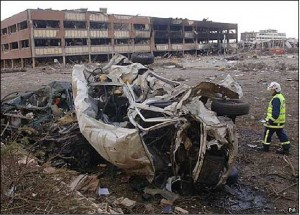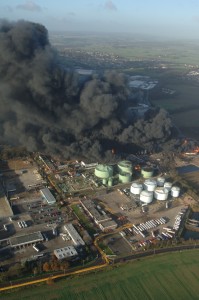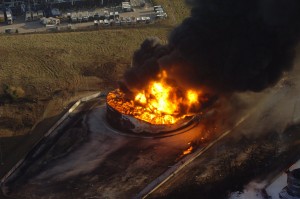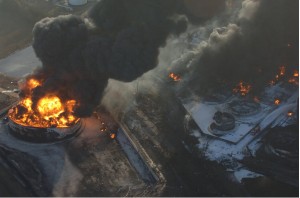Explosions followed by fire ripped through a fuel storage depot in Buncefield, England, located just 40 km north of London. The facility was storing 150,000 t of fuel (petrol, diesel fuel and kerosene) at the time of the accident. The 1st and largest explosion occurred at 6.01 am (measuring 2.4 on the Richter scale) and was heard 160 km away. The overpressure effects from the blast reached 700 to 1,000 mbar. Two other explosions occurred at 6.27 and 6.28 am. A gigantic blackish cloud containing irritating substances drifted across southern England, Brittany and Normandy December 12th, eventually reaching southwestern Spain. The authorities recommended residents living near the depot to remain indoors; 2,000 people were evacuated although were allowed to return to their homes the same evening. The M1 motorway connecting London to the Midlands was closed down for several days. The firemen were able to bring the fire under control after 60 hours, but the fumes from a tank initially spared by the flames caught fire on the morning of December 14th. During the most intense moments of the crisis, 180 firemen were mobilised along with 20 vehicles and 26 pump trucks. 786 m³ of foam concentrate and 68,000 m³ of water were used.Forty-three people were reported injured, most of who were injured by broken glass. The 10 employees present at the site at the time of the blast were uninjured. The impact of the fire on water quality was closely monitored, notably due to the presence of perfluorooctanoic sulfonate (PFOS), a toxic and persistent product used in foam concentrate. The firefighting water that could be contained on the site was recovered then temporarily stored at several sites around the country; however, 800 m³ were inadvertently released into a treatment station then into the River Colne. Total cost has still to be established but it will be in excess of 750 millions. Approximately 20 establishments employing 500 people were destroyed and roughly sixty employing 3,500 employees suffered considerable damage.The accident was caused by the ignition of a flammable vapour cloud, which had extended over 8 ha, and formed from more than 300 t of lead-free petrol that had spilled over from the roof of a diaphragm float tank that was being filled (Dec. 11, at 3 am: the level gauge remained static while the output remained the same; 5.20 am: the tank began to overflow; 5.50 am: The filling of another tank stops and the output to tank 912 reaches 890 m3/h; 6.01 al: 1st explosion). The ignition point, northeast of the depot, has not been precisely determined although hypotheses have been proposed: the pumping station, the heater in the emergency generator facility, car engines. Neither of the 2 alarm systems connected to the filling level detectors of tank 912 operated (level gauge + high level alarm). The supply was thus not stopped automatically and the malfunction was not reported by the supplier’s system, as it should have been via the high level alarm.
Download the detailed report in .pdf format (451 Kb)








